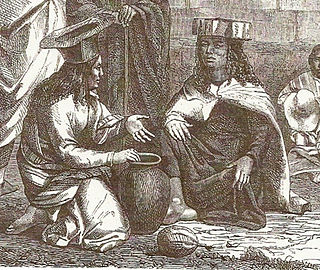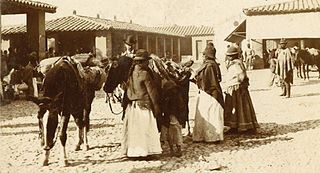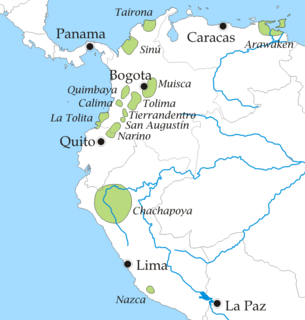 W
WThe Arawak are a group of indigenous peoples of South America and of the Caribbean. Specifically, the term "Arawak" has been applied at various times to the Lokono of South America and the Taíno, who historically lived in the Greater Antilles and northern Lesser Antilles in the Caribbean. All these groups spoke related Arawakan languages.
 W
WThe Atacama people, also called Atacameño, are indigenous people from the Atacama Desert and altiplano region in the north of Chile and Argentina and southern Bolivia.
 W
WThe Aymara or Aimara people are an indigenous nation in the Andes and Altiplano regions of South America; about 2.3 million live in Bolivia, Peru and Chile. Their ancestors lived in the region for many centuries before becoming a subject people of the Inca in the late 15th or early 16th century, and later of the Spanish in the 16th century. With the Spanish American Wars of Independence (1810–25), the Aymaras became subjects of the new nations of Bolivia and Peru. After the War of the Pacific (1879–83), Chile annexed territory with Aymara population.
 W
WThe Aymara kingdoms, Aymara lordships or lake kingdoms were a group of native polities that flourished towards the Late Intermediate Period, after the fall of the Tiwanaku Empire, whose societies were geographically located in the Qullaw. They were developed between 1150 and 1477, before the kingdoms disappeared due to the military conquest of the Inca Empire. But the current Aymara population is estimated at two million located in the countries of Bolivia, Peru, Chile and Argentina. They used the Aymara and Puquina languages.
 W
WThe Aztec Empire, or the Triple Alliance, was an alliance of three Nahua altepetl city-states: Mexico-Tenochtitlan, Tetzcoco, and Tlacopan. These three city-states ruled the area in and around the Valley of Mexico from 1428 until the combined forces of the Spanish conquistadores and their native allies under Hernán Cortés defeated them in 1521.
 W
WThe Kalinago, also known as the Island Caribs or simply Caribs, are an indigenous people of the Lesser Antilles in the Caribbean. They may have been related to the Mainland Caribs (Kalina) of South America, but they spoke an unrelated language known as Island Carib. They also spoke a pidgin language associated with the Mainland Caribs.
 W
WThe Emberá listen (help·info), also known in the historical literature as the Chocó or Katío Indians are an indigenous people of Panama and Colombia. In the Emberá language, the word ẽberá can be used to mean person, man, or indigenous person, depending on the context in which it is used. There are approximately 33,000 people living in Panama and 50,000 in Colombia who identify as Emberá.
 W
WThe Inca Empire, also known as the Incan Empire and the Inka Empire, was the largest empire in pre-Columbian America. The administrative, political and military center of the empire was in the city of Cusco. The Inca civilization arose from the Peruvian highlands sometime in the early 13th century. Its last stronghold was conquered by the Spanish in 1572.
 W
WThe Mapuche are a group of indigenous inhabitants of present-day south-central Chile and southwestern Argentina, including parts of present-day Patagonia. The collective term refers to a wide-ranging ethnicity composed of various groups who shared a common social, religious, and economic structure, as well as a common linguistic heritage as Mapudungun speakers. Their influence once extended from Aconcagua Valley to Chiloé Archipelago and later spread eastward to Puelmapu, a land comprising part of the Argentine pampa and Patagonia. Today the collective group makes up over 80% of the indigenous peoples in Chile, and about 9% of the total Chilean population. The Mapuche are particularly concentrated in the Araucanía region. Many have migrated from rural areas to the cities of Santiago and Buenos Aires for economic opportunities.
 W
WThe Maya peoples are an ethnolinguistic group of indigenous peoples of Mesoamerica. The ancient Maya civilization was formed by members of this group, and today's Maya are generally descended from people who lived within that historical civilization. Today they inhabit southern Mexico, Guatemala, Belize, El Salvador and Honduras. "Maya" is a modern collective term for the peoples of the region, however, the term was not historically used by the indigenous populations themselves. There was no common sense of identity or political unity among the distinct populations, societies and ethnic groups because they each had their own particular traditions, cultures and historical identity.
 W
WThe Muisca are an indigenous people and culture of the Altiplano Cundiboyacense, Colombia, that formed the Muisca Confederation before the Spanish conquest. The people spoke Muysccubun, a language of the Chibchan language family, also called Muysca and Mosca. As one out of many advanced civilizations of the Americas ,just to name a few, they were encountered by conquistadors ordered by the Spanish Empire in 1537 at the time of the conquest. Subgroupings of the Muisca were mostly identified by their allegiances to three great rulers: the zaque, centered in Hunza, ruling a territory roughly covering modern southern and northeastern Boyacá and southern Santander; the zipa, centered in Bacatá and encompassing most of modern Cundinamarca, the western Llanos; and the iraca, religious ruler of Suamox and modern northeastern Boyacá and southwestern Santander.
 W
WThe Muisca Confederation was a loose confederation of different Muisca rulers in the central Andean highlands of present-day Colombia before the Spanish conquest of northern South America. The area, presently called Altiplano Cundiboyacense, comprised the current departments of Boyacá, Cundinamarca and minor parts of Santander with a total surface area of approximately 25,000 square kilometres (9,700 sq mi).
 W
WThe Pucará culture was an archaeological culture which developed in Qullaw, along the north-western shore of Lake Titicaca. It was characterized by a hierarchy of sites made up several smaller centers and villages scattered throughout the northern basin of the Titicaca, ruled from its nucleus - the town of Pukara with an approximate extension of 6 square kilometers, constituted the first properly urban settlement in the Titicaca basin. Its sphere of influence reached as far north as the Cuzco Valley and as far south as Tiahuanaco. The culture had two phases of development within the Formative Period: the Middle Formative, and Late Formative.
 W
WQuechua people or Quecha people, may refer to any of the indigenous people of South America who speak the Quechua languages, which originated among the indigenous people of Peru. Although most Quechua speakers are native to the country of origin, there are some significant populations living in Ecuador, Bolivia, Chile, Colombia and Argentina.
 W
WThe Quimbaya civilization (/kɪmbaɪa/) was a Pre-Columbian culture of Colombia, noted for their gold work characterized by technical accuracy and detailed designs. The majority of the gold work is made in tumbaga alloy, with 30% copper, which imparts meaningful color tonalities to the pieces.
 W
WThe San Agustín culture is one of the ancient Pre-Columbian cultures of Colombia. Its beginnings go back at least to the fourth millennium B.C. Several hundred large monolithic sculptures have been found here.
 W
WTairona was a Pre-Columbian culture of Colombia, which consisted in a group of chiefdoms in the region of Sierra Nevada de Santa Marta in present-day Cesar, Magdalena and La Guajira Departments of Colombia, South America, which goes back at least to the 1st century AD and had significant demographic growth around the 11th century.
 W
WTimoto–Cuica people were an indigenous peoples of the Americas composed primarily of two large tribes, the Timote and the Cuica, that inhabited in the Andes region of western Venezuela. They were closely related to the Muisca people of the Colombian Andes, who spoke Muysccubun, a version of Chibcha. The Timoto-Cuicas were not only composed of the Timote and the Cuica groups, but also of smaller tribes including the Mucuchíes, the Miguríes, the Tabayes, and the Mucuñuques.
 W
WThe Tiwanaku Polity was a Pre-Columbian polity in western Bolivia based in the southern Lake Titicaca Basin. Tiwanaku was one of the most significant Andean civilizations. Its influence extended into present-day Peru and Chile and lasted from around 600 to 1000 AD. Its capital was the monumental city of Tiwanaku, located at the center of the polity's core area in the southern Lake Titicaca Basin. This area has clear evidence for large-scale agricultural production on raised fields that probably supported the urban population of the capital. Researchers debate whether these fields were administered by a bureaucratic state (top-down) or through a federation of communities with local autonomy. Tiwanaku was once thought to be an expansive military empire, based mostly on comparisons to the later Inca Empire. However, recent research suggests that labelling Tiwanaku as an empire or even different varieties of a state may even be misleading. Tiwanaku is missing a number of features used to define these types of polities: there is no defensive architecture at any Tiwanaku site or changes in weapon technology, there are no princely burials or other evidence of a ruling dynasty or a formal social hierarchy, no evidence of state-maintained roads or outposts, and no markets.
 W
WThe Wari were a Middle Horizon civilization that flourished in the south-central Andes and coastal area of modern-day Peru, from about 500 to 1000 AD.